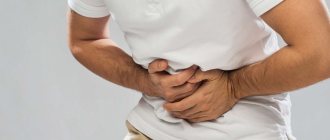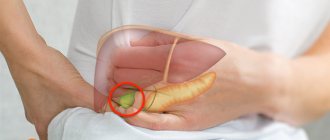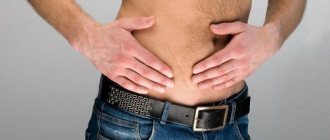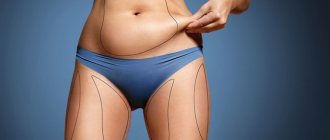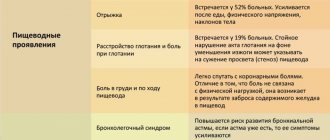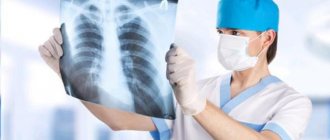Pain in the intestines on the right and left side of the lower abdomen can be caused by various reasons. This symptom is typical for people who have gastroenterological, gynecological and urological diseases. Pain in the intestines on the right and left side of the lower abdomen indicates pathologies in the pelvis. At the first complaint, the patient should contact a medical expert. At the private clinic “KDS Clinic”, specialists will conduct an initial examination, give advice and refer you for a diagnostic examination. We will help you determine the cause of the disease and select an individual treatment program.
Severe pain inside the abdomen is a clear sign of diseases that affect the large or small intestine. The process of spasms leads to the accumulation of lactic acid in the body, which irritates the nerve endings and causes pain.
Severe pain in the intestines is the result of poor nutrition, a side effect after taking medications, or an inflammatory process. Inflammatory processes in the intestines are accompanied by pain, nausea, bloating, colic and bad bowel movements.
Causes of pain
On the left side of the abdomen there are a large number of organs, each of which can cause pain. There are several possible causes for the condition:
- inflammation;
- injury;
- circulatory disorders (ischemia, heart attack);
- torsion of the ligaments of an internal organ;
- suppuration;
- systemic damage;
- genetic disease;
- poisoning;
- organ dysfunction;
- spasm;
- the appearance of a neoplasm.
A doctor should find out the cause during a face-to-face appointment. He will prescribe the necessary diagnostic procedures and select the optimal treatment.
Visceral pain
The cause of visceral pain can be functional disorders and organic changes in the organ. With functional disorders, this type of pain appears due to a decrease in the pain threshold and can affect all parts of the gastrointestinal tract2. In diseases of the digestive tract, visceral pain can be triggered by stretching, lack of blood supply, or peristalsis. Usually the patient feels it in the midline of the abdomen and is not able to accurately indicate the painful point2.
- The nature of visceral pain is cramping, with periods of subsiding and increasing pain. More often it can be described as aching, much less often - stitching or burning.
- Pain in diseases of the gastrointestinal tract can be caused by errors in diet, alcohol intake and exposure to factors such as running, bumpy riding, etc.
- The severity of pain can be reduced by warming or taking antispasmodics3.
Diagnostics
A doctor can guess the cause of pain through examination and palpation. The further diagnostic method is selected based on the results:
- general blood test - will indicate an infectious lesion, detect leukemia;
- general urinalysis - will help determine kidney pathology;
- Ultrasound is the fastest and easiest method for examining the abdominal organs;
- MRI - gives the most reliable results;
- colonoscopy - assessment of intestinal condition;
- radionuclide testing is relevant for some diseases of internal organs, for which other methods are not informative.
Based on the results of diagnostic measures, the patient is diagnosed. Pain treatment is selected according to the detected disease.
Read also: Pulling in the lower abdomen
Parietal pain
Another type of pain is parietal. It differs from the visceral one: it has a distinct localization in the area of the pathological process. Severe, painful and aggravated by sudden movements and coughing. It occurs due to irritation of the nerve receptors of the peritoneum, which covers the surface of the internal organs. It is projected onto the corresponding skin segments and is accompanied by tension in the muscles of the anterior abdominal wall2, 3.
Such pain, acutely occurring and intensifying, may be a sign of a serious pathology, so you should immediately consult a doctor3.
Possible diagnoses
Pain in the left side of the lower abdomen can be caused by damage to any organ located on this side. Possible diagnoses for such a patient:
- pathology of the spleen (abscess, heart attack, rupture, inflammation);
- lymphocytic leukemia or myeloid leukemia;
- intestinal pathology (malsorption, Crohn's disease, irritable bowel syndrome, ulcerative colitis, polyps, obstruction);
- oncology;
- pathologies of the reproductive organs (salpingitis, endometriosis, torsion of the ovarian pedicle, salpingoophoritis, adnexitis, rupture of uterine ligaments);
- ectopic pregnancy;
- kidney damage (enlargement of the pelvis).
Pain in the left side can be caused by other diagnoses, but radiate (transition) to this area. Therefore, it is important to contact a medical facility in a timely manner and conduct a comprehensive examination.
Causes of pain in the lower abdomen
The main causes of pain in the lower abdomen are as follows:
- Menstruation. Pain during menstruation is called dysmenorrhea. Dysmenorrhea can be primary (passes with the end of menstruation) and secondary (occurs against the background of an inflammatory process).
- Gynecological inflammatory diseases (adnexitis, endometritis, salpingitis, etc.). Most often accompanied by severe, aching pain that regularly bothers you. Other symptoms also appear, such as heavy discharge, a constant urge to urinate, a burning sensation and itching.
- Malignant formations;
- The presence of an ovarian cyst and symptomatic uterine fibroids;
- Endometriosis (a disease that damages the internal tissue of the uterus - the endometrium);
- Abortion;
- Consequences of inserting an intrauterine device.
Treatment
Treatment for a condition where the left side of the lower abdomen hurts depends on the diagnosis. Several groups of drugs can be used:
- painkillers - to relieve symptoms;
- antibiotics - for inflammation and suppuration;
- enzymes - for gastrointestinal pathologies;
- hormones - for endometriosis;
- sedatives - for irritable bowel syndrome;
- carminatives - for flatulence;
- chemotherapy - for oncology and leukemia.
If the pain is caused by kidney damage, special preparations and herbal teas may be prescribed. And in case of ectopic pregnancy, injuries and ruptures of organs, as well as in the absence of the ability to cure the patient with conservative methods, surgical intervention is performed.
Pain in the left side is a reason to consult a doctor in any case. But if they are of high intensity or began after a possible injury, this must be done urgently. Delay can threaten the patient with serious complications, including death.
Read also: Pulling in the lower abdomen during pregnancy
Dear patients! Remember that only a qualified doctor can make an accurate diagnosis, determine the causes and nature of the disease, and prescribe effective treatment. You can make an appointment with our specialists or call a doctor at home by calling 8-(4822)-33-00-33
Be healthy and happy!
Pain in the lower left abdomen during pregnancy
If pregnant women have aching or pain in the left lower abdomen, the reasons may be different. A physiological factor in the development of pain may be the attachment of the fertilized egg to the left wall of the uterus, which is felt by the woman as a slight aching pain.
Attachment of the fertilized egg may be accompanied by mild aching pain
Pathological causes of pain include:
- state of uterine hypertonicity;
- the beginning of a miscarriage;
- development of isthmic-cervical insufficiency;
- Braxton-Higgs contractions;
- digestive disorders.
In any case, it is recommended that a pregnant woman consult a gynecologist.
doctor
Specialized multidisciplinary clinic
Our staff consists of high-class doctors - members of the Russian and European Societies (EA).
We have a day hospital
We guarantee constant care for the patient and control over his recovery in the most comfortable conditions.
Low-traumatic treatment methods
We carry out operations with minimal intervention in the body using modern equipment of the new generation of intraoperative X-ray systems.
Why does it hurt in the groin in women?
Skin pathologies
Women who remove hair from their bikini area are more likely to develop localized infections in the hair follicle area.
Folliculitis is characterized by redness and the formation of a lump, followed by the formation of a conical pustule filled with pus. The pain is raw, aggravated by pressure and friction of linen. The general condition is not disturbed. The abscess opens spontaneously and heals within about a week. The rashes are often multiple in nature, spreading from the inguinal folds to the pubis and the anterior inner surface of the thighs. If hygiene rules are not followed or the immune system is weakened, complications in the form of boils, carbuncles and abscesses are possible. The progression of the infection is indicated by increased pain, twitching, throbbing pain that deprives you of sleep at night, increased body temperature, and deterioration of the general condition.
Hernias
Inguinal hernias are diagnosed less frequently in women than in men. Characterized by dull, constant or periodic pulling and aching painful sensations in the groin. Irradiation to the lumbosacral region is possible. If the bladder gets into the hernial protrusion, pain above the pubis and dysuric disorders are observed, if the cecum is flatulence, constipation. After operations, the formation of a recurrent inguinal hernia is possible, accompanied by the same symptoms as a regular hernial protrusion.
When a hernia is strangulated, there is a sharp increase in pain against the background of physical effort and abdominal tension. The painful sensations are acute, extremely intense, and are accompanied by the development of painful shock with increased heart rate, a drop in blood pressure and paleness of the skin. A decrease in pain intensity over several hours does not indicate normalization of the condition, but the development of necrotic changes and damage to nerve endings.
In addition, pain in the groin in women accompanies a femoral hernia. In the early stages, the pathology is asymptomatic or manifests itself as discomfort and slight pain during active movements. Subsequently, a protrusion appears in the inguinal-femoral fold, increasing with straining and vertical position of the body. The pain remains dull, aching, nagging, but its intensity increases somewhat. As in the previous case, when the intestines are involved, defecation disorders are observed, and when the bladder is affected, dysuria develops.
Lymphadenopathy due to STIs
Enlarged and painful inguinal lymph nodes in combination with itching of the genitals, pain during urination, and the appearance of pathological discharge from the genital tract may indicate the development of an STI. Lymph nodes are mobile elastic formations that are painful when touched. Local hyperemia and hyperthermia are possible. Inguinal lymphadenopathy in women is observed with the following genital infections:
- Genital herpes.
Malaise and general hyperthermia are noted. Along with the enlargement of the lymph nodes, the appearance of transparent small bubbles in the perineal area is characteristic. Elements of the rash spontaneously open, forming superficial erosions. - Gonorrhea.
Lymphadenopathy is bilateral, the nodes are slightly painful on palpation, the skin over them is slightly hyperemic. Purulent leucorrhoea with an unpleasant odor, itching and mild pain in the external genitalia, nagging pain in the lower abdomen, and dysuric disorders are detected. - Primary syphilis.
The lymph node is enlarged on one side, there is no significant pain, a feeling of discomfort prevails. Lymphadenopathy is preceded by the appearance of a painless ulcer (chancre) on the perineum or labia. When located in the vagina or on the cervix, chancre formation goes unnoticed.
In addition, minor pain in the groin caused by damage to regional nodes due to STIs can bother patients with chlamydia, mycoplasmosis and ureaplasmosis. However, in women this symptom appears less frequently than in men, due to a more pronounced tendency to a primarily chronic, asymptomatic course of the listed pathologies.
Groin pain in women
Other lymphadenopathy
The cause of nonspecific lymphadenitis with nagging, aching and bursting pain in the groin can be purulent wounds and local infectious processes (carbuncle, furuncle, cellulitis, abscess) of the lower limb. In case of varicose veins, this symptom may be due to the development of thrombophlebitis; in diabetes mellitus, it is associated with the formation of trophic ulcers. The lesion is characteristically unilateral. In acute conditions, intoxication is observed; painful red stripes may be found on the thigh - a sign of lymphangitis.
When the inflamed node suppurates, caused by hypothermia, decreased immunity against the background of concomitant diseases, a dangerous complication develops - adenophlegmon. Characterized by increasing, pulsating, bursting sharp pains that make movement difficult and deprive you of sleep. Weakness, hyperthermia, general intoxication, increased swelling and hyperemia on the affected side of the groin are noted. The contours of the lymph node become unclear, and after a while an area of fluctuation forms.
Painless or painless woody lymph nodes in the groin are also detected during metastasis of malignant tumors of the perineal skin (including vulvar melanoma). They are detected with cancer of the anus, neoplasms of the uterus, vagina and fallopian tubes.
Gynecological diseases
Pain in the groin in gynecological pathologies is caused by the close location of the genital organs, frequent irradiation to the groin area, and the development of lymphadenopathy. Caused by the following diseases:
- Vulvitis.
Enlarged lymph nodes occur even before other symptoms appear, but often go unnoticed due to the absence of pain. Then there is pain, burning and itching in the perineum, swelling and redness of the labia, pain when urinating. Pain from the affected area sometimes spreads to the inguinal folds. - Bartholinitis.
With non-purulent inflammation, lymphadenopathy, as in the previous case, is often asymptomatic. With the development of purulent bartholinitis and the formation of an abscess of the Bartholin gland, the node on the affected side increases significantly in size. Intoxication, hyperthermia, a combination of sharp, throbbing, jerking pain in the perineum with dull aching pain in the groin are observed. - Vaginitis.
Enlarged, slightly painful lymph nodes are detected on both sides. Dysuria, moderate nagging or aching pain in the lower abdomen, radiating to the groin, and pathological discharge from the vagina are noted. Body temperature is elevated to low-grade levels.
The symptom is also found in a number of other gynecological diseases. Pain in the lower abdomen radiating to the groin is accompanied by:
- adhesive disease after surgical interventions and inflammatory processes in the pelvis;
- emergency conditions: parametritis, pelvioperitonitis, ectopic pregnancy;
- lesions of the uterus and surrounding tissue: endometritis, large uterine fibroids;
- cervical pathologies: cervicitis, stenosis of the cervical canal;
- diseases of the ovaries and fallopian tubes: adnexitis, salpingitis, salpingoophoritis, ovarian cyst;
- other diseases: endometriosis, genital prolapse, algodismenorrhea.
Pathologies of the urinary organs
In women with urolithiasis, sudden, extremely intense pain in the groin is provoked by a low-lying stone. Combined with lower back pain. Weakness, pallor, frequent urge to urinate or urinary retention, and blood in the urine are noted. Other urinary system disorders that cause groin pain include:
- urethritis, urethral cancer;
- cystitis in women, detrusor injuries, bladder cancer;
- hydroureter, ureteritis;
- hydronephrosis, kidney adenocarcinoma.
Chronic pelvic pain syndrome
It manifests itself as a dull, aching painful sensation in the groin, lower abdomen, pubic area, perineum, sacrococcygeal region. CPPS in women is characterized by persistent pain, lack of clear localization, and a tendency for discomfort to migrate. The symptom lasts for 6 months or more. It intensifies against the background of hypothermia, defecation, urination, stress, exertion, and prolonged stay in a stationary position.
Gastrointestinal diseases
Pain in the right iliac and inguinal region is observed with a low location of the appendix. Acute appendicitis is characterized by cutting, burning, stabbing, jerking, dull or sharp pains, which are combined with diarrhea, nausea, vomiting, and general hyperthermia. In chronic appendicitis, the painful sensations are aching, dull, persist constantly, or occur during movements and diet disorders.
Pain in the groin on the left, complemented by pain in the abdomen and left iliac region, sometimes accompanies the following pathologies:
- sigmoiditis;
- irritable bowel syndrome;
- chronic constipation;
- sigmoid colon cancer;
- intestinal obstruction.
Lesions of the musculoskeletal system
Pain in the groin in women accompanies ARS syndrome. Pathology is diagnosed in female athletes. There is unilateral pain radiating to the leg and lower abdomen. The symptom intensifies with exertion, palpation of the damaged area, hip abduction, and muscle tension. In addition, irradiation to the groin is detected when:
- sprain of the hip joint;
- femoral neck fracture;
- coxarthrosis.
Medical examination
Pathologies of the kidneys and ureters
Urolithiasis causes pain.
The kidney is a paired organ. Therefore, problems with the urinary system can be bilateral or unilateral.
In case of pathology of one of the kidneys, the symptoms may be hidden or not clearly expressed.
Therefore, pyelonephritis develops rapidly, since 2 kidneys are involved, and, for example, a stone in one of them does not manifest itself for a long time. Causes of pain:
- Urolithiasis and its manifestation renal colic. It occurs when stones or sand begin to move from the kidney down the ureter, scratching its walls. Pain syndrome occurs. It can be cramping - if there is a stone or constant strong along the ureter to the urethra - if there is sand.
- Hydroureteronephrosis is overstretching of the renal pelvis. The cause is a narrowing of the urinary tract due to various reasons. Urine accumulates in the kidney, the tissues experience pressure, and pain occurs.
